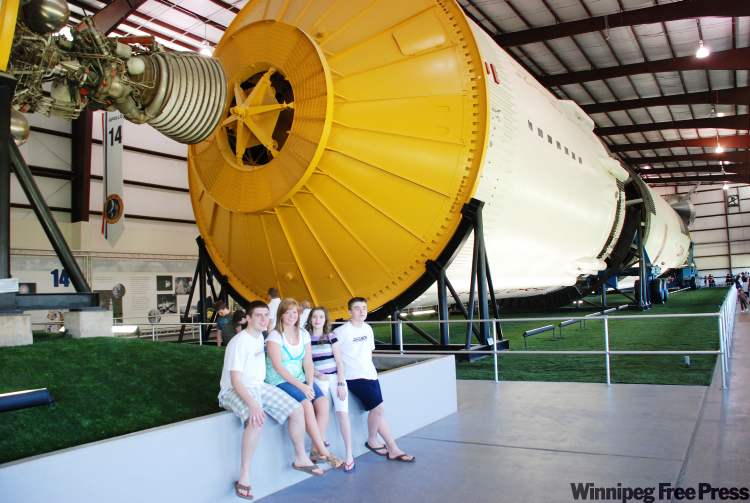An inside view of Johnson Space Center
Tour lets visitors see behind-the-scenes workings of Apollo 13 mission
Advertisement
Read this article for free:
or
Already have an account? Log in here »
To continue reading, please subscribe:
Monthly Digital Subscription
$0 for the first 4 weeks*
- Enjoy unlimited reading on winnipegfreepress.com
- Read the E-Edition, our digital replica newspaper
- Access News Break, our award-winning app
- Play interactive puzzles
*No charge for 4 weeks then price increases to the regular rate of $19.00 plus GST every four weeks. Offer available to new and qualified returning subscribers only. Cancel any time.
Monthly Digital Subscription
$4.75/week*
- Enjoy unlimited reading on winnipegfreepress.com
- Read the E-Edition, our digital replica newspaper
- Access News Break, our award-winning app
- Play interactive puzzles
*Billed as $19 plus GST every four weeks. Cancel any time.
To continue reading, please subscribe:
Add Free Press access to your Brandon Sun subscription for only an additional
$1 for the first 4 weeks*
*Your next subscription payment will increase by $1.00 and you will be charged $16.99 plus GST for four weeks. After four weeks, your payment will increase to $23.99 plus GST every four weeks.
Read unlimited articles for free today:
or
Already have an account? Log in here »
Hey there, time traveller!
This article was published 04/12/2010 (5496 days ago), so information in it may no longer be current.
APOLLO 13 is one of the most famous of NASA’s Apollo missions to the moon — not because the astronauts succeeded in landing on the moon, but because they were successful in returning to Earth.
Apollo 13 was the third Apollo mission intended to land on the moon, but an oxygen tank rupture made a lunar landing impossible and put the lives of the crew in danger. Fortunately, the ship and its crew made it safely back to earth on April 17, 1970 — just more than 40 years ago.
The entire world breathed a sigh of relief, but nobody celebrated more than the people working at mission control in Houston’s Johnson Space Center.

On a recent visit to the centre, we had the chance to go behind the scenes and see the original mission control and meet a man who used to work there. Terry Hartman worked in Mission Control when the Apollo 13 incident took place. He was also in Mission Control on the day Neil Armstrong walked on the moon, so when he tells you what Mission Control was like back in the day — you can believe him.
“In 1969 we used state-of-the-art equipment including rotary dial phones and slide rulers in Mission Control,” Hartman said with a laugh during a recent tour of the facility. “Those screens you see in the green room aren’t computers like we have today, either. Each person looked at raw data on the screen and had to relate it back to what was actually happening aboard the ship.”
Hartman is retired now, but still gives tours to visitors that come to see the behind-the scenes workings of the centre.
Although some of our children questioned the wisdom of standing in the 45-minute lineup to go on the NASA tram tour, meeting Hartman and hearing his presentation made it all worthwhile.
The tram tour also allowed us to see the astronaut training facility and watch astronauts working with replicas of the space shuttle and the International Space Station — including the Canadarm.
The behind-the-scenes tour ended with a stop at Rocket Park to see actual rockets used in NASA’s space program.
Our guide explained that there is a backup made for every rocket and space module used in the space program. When the Apollo 13 astronauts were in the midst of their crisis, astronauts and centre employees worked frantically with the backup rocket and simulators to develop a strategy to get the astronauts home.
— Postmedia News
IF YOU GO
Admission to Space Center Houston is US $19.95 per adult and $15.95 per child. Visiting the space centre is a full-day event. In addition to the opportunity to have a behind-the-scenes tram tour of Johnson Space Center, there is a large play area for younger children, flight simulators, displays, and presentations. To purchase tickets online or to find out more information, visit: www.spacecenter.org.
The behind-the-scenes tram tour will take 90-minutes and lineups can add another hour to that. To avoid a long lineup, plan your tram tour early on the day of your visit.
If you are planning to visit several attractions in Houston, consider purchasing a Houston Citypass for $39 per adult and $29 per child. The pass provides admission to six of the city’s most popular attractions, including Space Centre Houston, and will save you money if you visit several attractions. For more information, visit: www.citypass.com.
While in Houston, we stayed at the Houston Intercontinental Hotel. The hotel is located near The Galleria, the largest shopping area in the city, and has large rooms that are well suited to accommodate families. Standard rooms start at $129 per night, depending on the dates of travel, with executive suites costing about $30 more per night. Executive suites include access to a special lounge with breakfast, lunch and dinner snacks, and a complimentary evening cocktail hour. There is an excellent fitness area and an outdoor rooftop pool. For more information or reservations, visit: www.ichotelsgroup.comor call 1-877-660-8550.
For help planning a visit to Houston, Texas, visit: www.visithoustontexas.com. For more information on Houston and other great vacation spots in Texas, visit www.traveltex.com.
Kids’ Stuff
NASA on the Internet: For more information on NASA and its space programs, visit: www.nasa. gov. For kid-friendly activities and space games, visit the NASA KidsClub at: www.nasa.gov/audience/forkids/kidsclub/flash/index.html.

